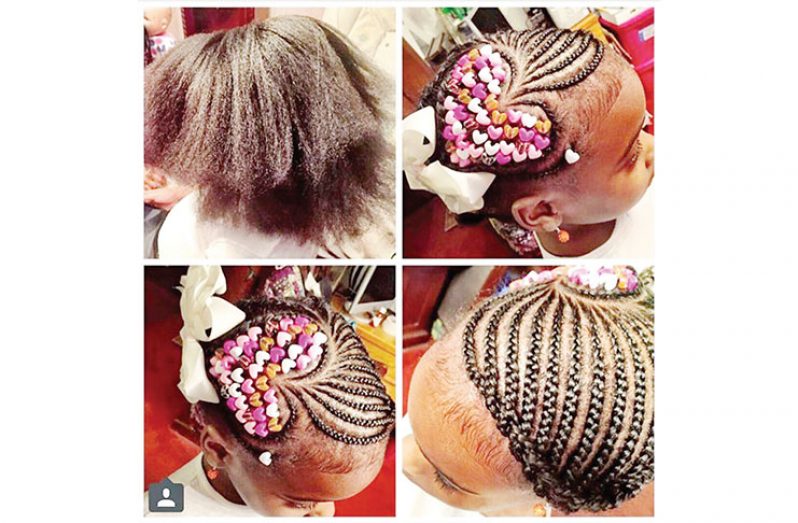A PROMINENT African-Guyanese woman explained that when an African woman braids her daughter’s hair, it creates an atmosphere for bonding and as it takes time to skillfully bind the strands, even values are passed down.
 “Braiding is not just an art, but it is an expression of love, an avenue for greater intimacy,” Ms. Carmen, a middle-aged woman in a culture-rich countryside community said.
“Braiding is not just an art, but it is an expression of love, an avenue for greater intimacy,” Ms. Carmen, a middle-aged woman in a culture-rich countryside community said.
Ms. Carmen recalled in her youthful days when her own mom braided her hair and taught her many things. Her preparation for the adolescent stage of her life was done during this time and mom would tell her stories of her own ancestors and family traditions.
She explained that as the child sits between her mother’s legs and rests her head comfortably on the woman’s thighs, it creates a comfort that is not found anywhere else. And even when salon professionals do the job, it does not carry the same value as that done by mom.
“There is no better person to cornrow a little girl hair than her mama,” Ms. Carmen told Pepperpot Magazine.
In the olden days it fashioned the perfect opportunity for woman to tell stories, hear concerns and teach the young girl something new, and that is why parents are encouraged to spend more time with their children, particularly girls, braiding their hair.
Braiding is forever fashionable, and even as it has its roots in the African tradition, Pepperpot Magazine understands that ‘cornrows’ received its name from the Africans who worked on corn fields, as the braiding was organized in such ways making it reminiscent of the well-organized corn fields.
Here in the Caribbean, many people call the hairstyles ‘canerows’ as it resembles the sugarcane fields planted during the slave trade.
Cornrows were popularly done within living rooms, bedrooms, on stairways or on benches in the yard at a family home. Even though many parents take their girls to the beautician for a weekly hairdo, there is no better comfort than a daughter’s head resting on her mother’s thigh while her scalp is being massaged by gentle fingers.
It is of concern to some that many have moved away from the traditional cornrows and are detangling the roots of the African people with the use of chemicals to lighten hair texture. But even with texture, one can still have their child’s hair feature the intricate cultural art form.
Ebony magazine defines cornrows as “the result of hair that’s braided flat against the scalp… An intricate art form… the cornrow braiding process takes anywhere from a few minutes to several hours to complete, depending on the size of the braids and the hair’s density.”
The stylist has endless patterns to choose from and many times those who plait create their own new design on the head of the person who is getting a hair fix.
While Pepperpot Magazine learnt that there are basically two types of cornrows – with the overhand or ‘bread’ design featuring the braids lying on top of the scalp, the underhand or ‘hassaback’ technique carries an inverted look and is also called inside cornrows.
Patterns such as flowers, bows, hearts, baskets and even names of individuals are crafted through the braids. The hairstyle can last weeks, but many times, with much care, are left no longer than two weeks.
Braids can be maintained by covering with a silk scarf or stockings to sleep, preventing frizz, and oiling of the scalp to moisturise.
This week Pepperpot Magazine recommends a few fashionable cornrow/canerow hair designs, which moms can try for the upcoming holiday season.




.png)









